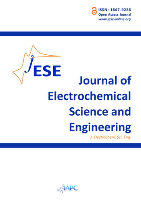
Journal of Electrochemical Science and Engineering
Scope & Guideline
Connecting Researchers to the Future of Electrochemical Applications.
Introduction
Aims and Scopes
- Electrochemical Sensors and Biosensors:
The journal publishes research on the development and application of electrochemical sensors, particularly those utilizing novel materials for the detection of biological, environmental, and chemical analytes. - Energy Storage and Conversion Technologies:
Research on batteries, supercapacitors, and fuel cells, including advancements in electrode materials, electrolytes, and overall system performance, is a significant focus area. - Corrosion Science and Engineering:
Studies addressing corrosion mechanisms, prevention strategies, and the development of corrosion-resistant materials are routinely featured, highlighting the importance of electrochemistry in extending the lifespan of materials. - Electrochemical Processes in Environmental Applications:
The journal includes articles on the application of electrochemical techniques for wastewater treatment, pollutant detection, and resource recovery, reflecting the growing concern for environmental sustainability. - Material Science in Electrochemistry:
Research on the synthesis, characterization, and application of novel materials, including nanomaterials and composites, for various electrochemical applications is a critical area of focus.
Trending and Emerging
- Advanced Materials for Energy Applications:
There is a growing emphasis on the development of advanced materials, such as nanomaterials and composites, for improving the performance of energy storage devices and fuel cells. - Biocompatible Electrochemical Systems:
Research into biocompatible materials and systems for biomedical applications is on the rise, particularly in the context of sensors and drug delivery systems. - Sustainable and Green Electrochemistry:
An increasing number of studies focus on sustainable practices in electrochemistry, including the use of renewable resources and environmentally friendly processes in sensor and energy device development. - Electrochemical Techniques in Wastewater Treatment:
The application of electrochemical processes for treating wastewater and recovering valuable resources is emerging as a significant trend, reflecting a broader interest in environmental remediation. - Integration of Artificial Intelligence in Electrochemistry:
The incorporation of AI and machine learning techniques to optimize electrochemical processes and materials development is gaining momentum, indicating a future direction for research.
Declining or Waning
- Traditional Corrosion Inhibitors:
Research on conventional organic corrosion inhibitors has decreased as the focus shifts towards greener and more sustainable alternatives, such as biobased inhibitors. - Basic Electrochemical Theory:
While foundational electrochemical theory remains important, the journal has seen fewer publications focused solely on theoretical aspects without accompanying experimental validation or application. - Electrochemical Methods in Non-Energy Applications:
There has been a notable decline in studies applying electrochemical methods to non-energy applications, such as traditional analytical chemistry, as researchers increasingly target energy-related innovations. - Single-Fuel Microbial Fuel Cells:
Research specifically focused on single-fuel microbial fuel cells has declined, likely due to a broader interest in multi-fuel systems that can optimize energy output.
Similar Journals

International Journal of Electrochemical Science
Bridging theory and practice in electrochemical science.International Journal of Electrochemical Science is a peer-reviewed journal dedicated to disseminating cutting-edge research in the field of electrochemistry. Published by Elsevier in Serbia, this journal serves as a vital platform for scientists and researchers to explore innovative electrochemical techniques, processes, and applications. With an ISSN of 1452-3981, it has been a respected source of scholarly articles since its inception in 2006 and continues to bridge the gap between theoretical advancements and practical implementations up until 2024. Notably, it holds a Q4 quartile ranking in the field of electrochemistry and ranks 41 out of 60 in the Scopus database, situating it within the 32nd percentile among its peers. The journal champions open academic discourse, contributing significantly to the advancement of knowledge in electrochemical sciences, making it an essential resource for researchers, professionals, and students alike who are striving towards new discoveries and innovations.

Electrochemical Energy Reviews
Transforming Energy Landscapes with Cutting-edge ResearchElectrochemical Energy Reviews, published by SpringerNature, serves as an essential platform for the dissemination of cutting-edge research in the fields of electrochemistry, material science, and energy engineering. With an impressive impact factor and ranked in the Q1 category across multiple disciplines including Chemical Engineering and Energy Technology, this journal highlights its commitment to advancing knowledge and innovation within the energy sector. Operating since 2018, the journal not only provides a valuable resource for researchers and professionals but also invites contributions from students and emerging scholars interested in the pivotal role of electrochemical processes in sustainable energy solutions. Published in Germany and widely accessible to the global research community, Electrochemical Energy Reviews is an indispensable reference for those keen on exploring the future of energy technologies.

JOURNAL OF SOLID STATE ELECTROCHEMISTRY
Advancing the Frontiers of Solid-State ElectrochemistryThe Journal of Solid State Electrochemistry is a leading peer-reviewed journal dedicated to advancing the understanding and application of solid-state electrochemical systems. Published by Springer, this prestigious journal has been a staple in the field since its establishment in 1997, with an impressive range of topics covering Condensed Matter Physics, Electrochemistry, and Materials Science. It holds a notable Q2 category quartile ranking in several disciplines, including Electrical and Electronic Engineering, and boasts significant Scopus rankings—ranked #28 in Electrochemistry, showcasing its credibility and impact in the field. With a mission to disseminate high-quality research and innovative methodologies, the journal aims to foster cross-disciplinary collaboration among researchers, professionals, and students. While not open access, articles published in the Journal of Solid State Electrochemistry are integral for those exploring cutting-edge technologies through theoretical and practical approaches, ultimately enhancing our understanding of energy systems and materials' performance. Located in Germany, the journal continues to thrive internationally, providing a robust platform for scholarly communication.
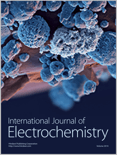
International Journal of Electrochemistry
Exploring the synergy of science and innovation in electrochemistry.The International Journal of Electrochemistry, published by HINDAWI LTD, serves as a premier outlet for cutting-edge research in the expansive field of electrochemistry. With an ISSN of 2090-3529 and an E-ISSN of 2090-3537, this open-access journal has been contributing to the advancement of scientific knowledge since 2011, making its content freely available to researchers, industry professionals, and students around the globe. The journal aims to foster innovation by disseminating high-quality research articles, reviews, and technical notes that encompass a wide range of topics from fundamental electrochemical principles to practical applications in energy storage, sensors, and material development. With a focus on promoting interdisciplinary collaboration and advancing the understanding of electrochemical systems, the International Journal of Electrochemistry is a vital resource for anyone involved in electrochemical research and its applications.

Journal of Electrochemical Science and Technology
Catalyzing Innovation in Electrochemical TechnologiesJournal of Electrochemical Science and Technology, with the ISSN 2093-8551, is a distinguished publication in the field of electrochemistry, disseminated by the Korean Electrochemistry Society. Based in South Korea, the journal has made significant strides since its inception in 2014, showcasing groundbreaking research that spans various applications of electrochemical science. Currently ranked in the Q2 category for Electrochemistry, it occupies an emerging position within the academic community, evidenced by its Scopus rank of #25 out of 60 in the Electrochemistry domain, placing it in the 59th percentile. Although the journal follows a traditional access model, it remains committed to providing high-quality, peer-reviewed content that fuels innovation and scholarly dialogue. With objectives firmly rooted in advancing the understanding and application of electrochemical phenomena, this journal serves as a crucial resource for researchers, professionals, and students alike, striving to push the boundaries of the electrochemical sciences.
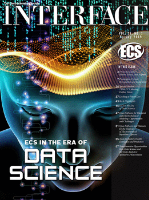
Electrochemical Society Interface
Transforming Electrochemical Discoveries into Practical AdvancesElectrochemical Society Interface is a prominent journal within the field of electrochemistry, published by the Electrochemical Society Inc. The journal, carrying the ISSN 1064-8208 and E-ISSN 1944-8783, serves as a vital platform for researchers, professionals, and students alike, aiming to bridge the gap between cutting-edge research and practical applications in the electrochemical domain. With a convergence period spanning from 1992 to 2024, the journal enjoys a respectable ranking in the Q3 Quartile of the 2023 Electrochemistry category. Although it does not currently offer open access options, its articles provide valuable insights into various aspects of electrochemical research and technology, enhancing the scholarly communication in this important field. By maintaining high standards in research dissemination, Electrochemical Society Interface continues to foster innovation and contributes significantly to the developments in electrochemical processes and materials.

Analytical & Bioanalytical Electrochemistry
Pioneering Research in Electrochemical AnalysisAnalytical & Bioanalytical Electrochemistry is a pivotal journal dedicated to the advancement of research and innovation in the fields of analytical chemistry and electrochemistry. Published by the University of Tehran, Faculty of Chemistry, Center of Excellence in Electrochemistry, this journal has been contributing to the scientific community since its inception in 2009 and continues to be a critical platform through 2024. With an ISSN of 2008-4226, it focuses on a variety of topics including electrochemical sensors, bioanalytical techniques, and innovative methodologies in electrochemical analysis. Although it currently holds a Q4 quartile ranking in both analytical chemistry and electrochemistry categories, its unique insights and research findings are essential for advancing knowledge and fostering interdisciplinary collaboration within the scientific community. Researchers, professionals, and students engaged in these dynamic fields will find valuable resources and contribute to the ongoing discourse by publishing their work in this journal. We invite you to explore and engage with the diverse content that Analytical & Bioanalytical Electrochemistry offers to enhance your research and professional development.
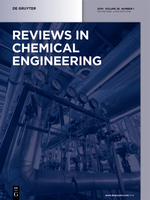
REVIEWS IN CHEMICAL ENGINEERING
Fostering Interdisciplinary Collaboration and Innovation.REVIEWS IN CHEMICAL ENGINEERING, published by Walter de Gruyter GmbH, is a premier journal that delivers cutting-edge insights and comprehensive reviews in the field of chemical engineering. Established as an eminent resource since 1982, this journal is committed to advancing knowledge and fostering innovation in various domains of chemical engineering, including process design, materials, and environmental considerations. With an impressive Q1 ranking in the 2023 Scopus category for Chemical Engineering and a commendable 20th position out of 273 journals, it is recognized for its rigorous peer-review process and high-impact contributions. Although it operates under a subscription model, the journal remains a vital platform for researchers and professionals aiming to stay at the forefront of technological advancements and scholarly discourse in chemical engineering. With a focus on interdisciplinary applications and real-world relevance, REVIEWS IN CHEMICAL ENGINEERING is an indispensable resource for academics, industry professionals, and students dedicated to excellence in this field.
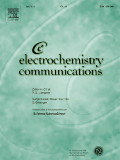
ELECTROCHEMISTRY COMMUNICATIONS
Empowering Researchers with Cutting-Edge Electrochemical KnowledgeELECTROCHEMISTRY COMMUNICATIONS, published by ELSEVIER SCIENCE INC, is a leading journal in the field of electrochemistry, holding a prestigious position in the Q1 quartile since 2023. With an impact factor reflecting its esteemed reputation, the journal ranks #15 out of 60 in the Scopus Chemistry category for Electrochemistry, placing it in the 75th percentile. Since adopting an Open Access model in 2019, it has garnered widespread visibility and accessibility, enabling researchers and professionals to share groundbreaking findings and foster innovation. Covering a wide range of topics from fundamental electrochemical research to practical applications, ELECTROCHEMISTRY COMMUNICATIONS serves as a critical platform for disseminating knowledge and advancing the field. The journal's commitment to quality and relevance positions it as a vital resource for academics and practitioners striving to stay at the forefront of electrochemical science.
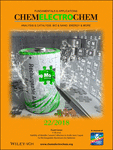
ChemElectroChem
Advancing the frontiers of catalysis and electrochemistry.ChemElectroChem is a premier open-access journal published by WILEY-V C H VERLAG GMBH, focusing on the interdisciplinary fields of catalysis and electrochemistry. Established in 2014 and actively publishing until 2024, this journal boasts an impressive reputation, currently ranked in the Q2 category for both catalysis and electrochemistry according to the 2023 metrics. With an Scopus ranking placing it in the 74th percentile for Electrochemistry and 61st for Chemical Engineering and Catalysis, ChemElectroChem serves as an essential platform for researchers, professionals, and students dedicated to advancing knowledge and fostering innovation in these critical scientific domains. Since its transition to open access in 2023, the journal aims to maximize the dissemination of cutting-edge research and facilitate the exchange of ideas among global scholars, thereby enhancing the accessibility and impact of high-quality science within the community. For those engaged in the ever-evolving conversations around energy storage, conversion processes, and sustainable solutions, ChemElectroChem is an invaluable resource.